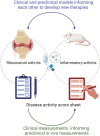Bench to Bedside: Modelling Inflammatory Arthritis
- PMID: 38567064
- PMCID: PMC10917191
- DOI: 10.1093/discim/kyac010
Bench to Bedside: Modelling Inflammatory Arthritis
Abstract
Inflammatory arthritides such as rheumatoid arthritis are a major cause of disability. Pre-clinical murine models of inflammatory arthritis continue to be invaluable tools with which to identify and validate therapeutic targets and compounds. The models used are well-characterised and, whilst none truly recapitulates the human disease, they are crucial to researchers seeking to identify novel therapeutic targets and to test efficacy during preclinical trials of novel drug candidates. The arthritis parameters recorded during clinical trials and routine clinical patient care have been carefully standardised, allowing comparison between centres, trials, and treatments. Similar standardisation of scoring across in vivo models has not occurred, which makes interpretation of published results, and comparison between arthritis models, challenging. Here, we include a detailed and readily implementable arthritis scoring system, that increases the breadth of arthritis characteristics captured during experimental arthritis and supports responsive and adaptive monitoring of disease progression in murine models of inflammatory arthritis. In addition, we reference the wider ethical and experimental factors researchers should consider during the experimental design phase, with emphasis on the continued importance of replacement, reduction, and refinement of animal usage in arthritis research.
Keywords: 3Rs; Rheumatoid arthritis; TNF; clinical score; murine models of arthritis.
© The Author(s) 2022. Published by Oxford University Press on behalf of the British Society for Immunology.
Conflict of interest statement
CIC, MW and HMM received funds from Dompe Pharmaceuticals. All other authors have no conflict of interests to declare.
Figures





References
-
- Janke K, Biester K, Krause D, Richter B, Schürmann C, Hirsch K, et al. . Comparative effectiveness of biological medicines in rheumatoid arthritis: systematic review and network meta-analysis including aggregate results from reanalysed individual patient data. BMJ 2020, 370, m2288. doi:10.1136/bmj.m2288. - DOI - PMC - PubMed
-
- Buckley CD, Ospelt C, Gay S, Midwood KS.. Location, location, location: how the tissue microenvironment affects inflammation in RA. Nat Rev Rheum 2021, 17, 195–212. - PubMed
Publication types
Grants and funding
LinkOut - more resources
Full Text Sources
